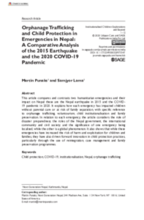Abstract
This article compares and contrasts two humanitarian emergencies and their impact on Nepal: these are the Nepal earthquake in 2015 and the COVID-19 pandemic in 2020. It explains how each emergency has impacted children without parental care or at risk of family separation, with specific reference to orphanage trafficking, voluntourism, child institutionalisation and family preservation. In relation to each emergency, the article considers the role of disaster preparedness; the roles of the Nepal government, the international community and civil society; and the significance of one emergency being localised, while the other is a global phenomenon. It also shows that while these emergencies have increased the risk of harm and exploitation for children and families, they have also driven forward innovation in child protection practices, particularly through the use of reintegration, case management and family preservation programmes.

